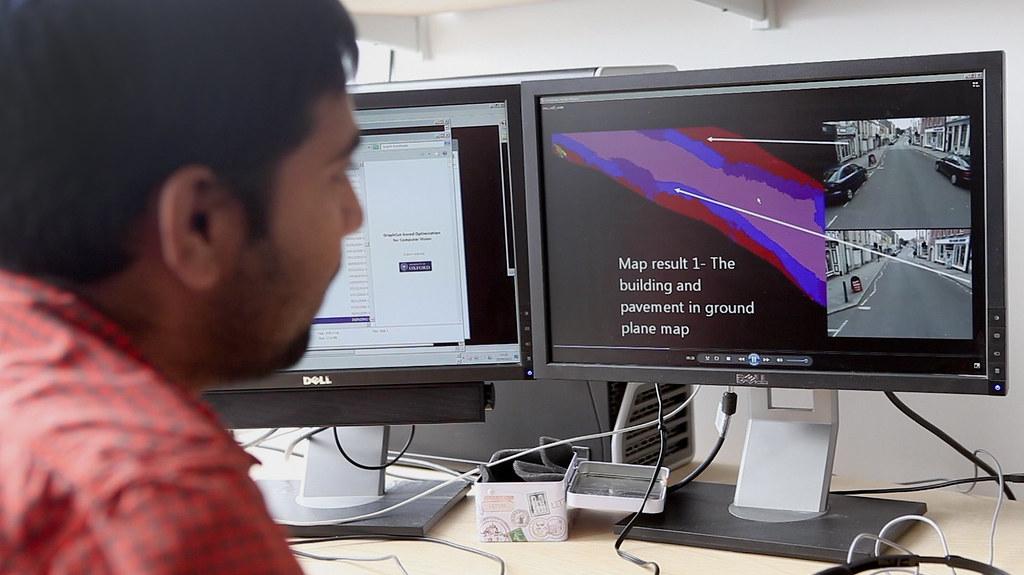Computer vision technology allows it to see and understand the world. It sounds incredible, right? As a computer vision engineer, I witness it every day. And I’m also one of the experts behind this technology.
If you wonder how to become a computer vision engineer, this guide must be what you need now. I will share my experience on this career path with you.
So, let’s dive in right now!
Who Is A Computer Vision Engineer?
Computer vision engineers refer to artificial intelligence (AI) techniques that aim to make computers perceive visual information to address real-world problems.
Snapchat is an example of computer vision technology. This app allows you to add filters or stickers to certain positions of your face.
A computer vision engineer is in charge of this app development. They work with visual information. The data comes from multiple sources, such as digital signals, analog images, or video feeds that computers can digitize.

Roles and Responsibilities
I’m a computer vision engineer. I work with interesting technologies every day. Here is what keeps my work days busy:
- I develop computer vision algorithms for different purposes. This task also involves testing, debugging, and deploying the algorithms.
- I work with autonomous hardware and robots, too. Thus, I have to create automated algorithms.
- The algorithms need upgrading. As a computer vision engineer, I analyze their current performance and improve their features.
- There can be real-world issues in the systems. So, I study them and recommend creative and practical solutions to tackle them.
- I develop computer vision systems for my clients and company. So, I prepare technical documentation to make them understand the systems and use them correctly.
- I must join meetings with my team to define each project’s requirements, plan the budgets, and execute them.
How To Become A Computer Vision Engineer
If you want to become a computer vision engineer, your journey will be filled with many challenges. But don’t worry because you can pull it off with your passion for this field.
1. Get a Strong Foundation
Study first! Once you have a solid knowledge background, you can be confident moving forward.
You should start with a bachelor’s degree in computer science or information systems. These majors provide you with a deep understanding of computer systems and algorithms.
You have many education paths to consider. But whatever you choose, focus on these concepts:
Programming
You need to code when developing computer vision applications. Python is the most popular programming language for computer vision engineers.
C++ is also a good idea. It provides high performance with an extensive library to support machine learning (ML) solutions.
I highly recommend MATLAB. It’s excellent for fast prototyping and generating new ideas. The adaptability to the research environment is another plus.
Image processing methods and tools
Working with image processing is a must. Hence, you need to master image processing methods and tools. After trying tons of them, I like the following options the most:
- TensorFlow: This open-source library is ideal for ML. You can use it to create and manage neural networks. It can also support ML models with complex numerical computation.
- YOLO: I often use this algorithm to spot real-time objects. The core of YOLO is its convolutional neural network.
- Keras: Like TensorFlow, Keras is a free and open-source library. It can help deploy deep learning models.
- PyTorch: As the name suggests, this library aims to support Python Code. You can also use it for image processing and NLP.
Mathematical roots
You must be good at math to become a computer vision engineer. At least, you have to deal well with these foundational mathematics:
- Linear algebra
- Pattern recognition
- Bayesian Probability
- 3D geometry
Computer vision techniques
There are many computer vision techniques to learn. You should start with these first:
- Semantic segmentation: An image has many objects. So, you need semantic segmentation to identify those objects first, then label them into classes. For example, if a picture has five cats, you can segment the cats as a class and name it “cat.”
- Instance segmentation: This concept is completely different from semantic segmentation. All the objects in an image are similar. Thus, you can identify them as distant instances. So, with a picture of five cats, you will segment each cat as an object.
- Object localization: This process occurs when you identify the position of one or more objects in one picture.
- Object detection: After locating the objects, you draw a bounding box around their extent. This technique is “object detection.” It helps you measure the object’s scale and its location in the image.
- Object tracking: A video has moving objects. Thus, you need the object tracking technique to follow them.
- Face recognition: This technique is familiar when you take a picture of yourself or others. It uses deep learning and neural networks to work.

2. Obtain a certificate
You can obtain certifications in computer vision to strengthen your knowledge. There are many online courses to choose from.
Convolutional Neural Networks course (from Coursera)
I have mentioned “neural networks” many times, right? They are important for image processing. So why don’t you dig deeper into this topic?
The Convolutional Neural Networks course from Coursera will teach you how to apply this concept to your visual recognition and detection tasks. The instructors also give tips for writing effective codes for your software.
The course has different sections, each with small questions and assessments to help you follow the program easily. After completing the exercises and assignments, you can earn the certification.
Introduction to Computer Vision (from Coursera)
If computer vision is new to you, try this course. I took it when I first stepped into this industry, and it was amazing.
By the end of the course, you can use Python, OpenCV, and Watson AI to process pictures. You can even handle image classification systems effortlessly.
Moreover, the course gives you free access to cloud environments. Then, feel free to create your computer vision apps there.
Python for Computer Vision (from Udemy)
This course is one of the best options for using Python in computer vision. You can practice with feature matching and face detection techniques in the classes.
In addition, you will study deep learning networks and optical flows. They will surely be your secret weapons when working as a computer vision engineer.
However, this course is for intermediate-level learners. It means you should be familiar with Python before attending the classes.

3. Gain experience
Once you’ve got the techniques, practice using them. Experience will help you become the computer vision engineer that all companies desire.
You can get hands-on experience by joining computer vision projects. You can try these ideas:
- Face recognition: This project helps identify a person’s face. You can learn to work with Keras, TensorFlow, and neural networks when developing the app. Haar Cascade is also a good algorithm for your project.
- Object detection: You can develop an app for detecting objects and labeling them appropriately.
- Road lane: Autonomous cars use road lane detection systems to detect the road’s curvatures. This project is more complicated than the other two. But when you can nail it, you will improve your skills significantly.
Another idea for gaining experience is to take an internship. When working as an intern, you can observe how professionals execute a computer vision project in reality.

4. Develop skills
Skills set you apart from other candidates when applying for a computer vision position. But what skills do employers look for?
Technical skills
These skills ensure you can handle computer vision projects properly. Here is what you should focus on:
- Programming: Practice coding in Python and C++. They are the best tools to develop a computer vision application.
- Image processing: This skill involves filtering, converting, and analyzing visual information.
- Database management: You need to understand data flow and database management.
- Machine learning: ML frameworks are part of your job. So, learn how to use PyTorch, Keras, and TensorFlow smoothly.
Soft skills
Do not focus only on the technical side. You need to develop your soft skills, too:
- Problem-solving: There will be tons of problems when working on computer vision. Hence, you need to break down complex issues into manageable parts and deal with them one by one.
- Communication: You have to interact with your clients and stakeholders to understand their needs. And after developing the app, you will prepare documentation for the end users. Thus, hone your communication skills today.
- Analytical thinking: As a computer vision engineer, you analyze data sets every day. That’s why you need good analytical abilities.

5. Build your portfolio
Remember the projects you have done in step 3? If you feel proud of them, include them in your portfolio.
The portfolio is simply a place to highlight your previous work. It showcases your skills and experience. When you apply for any job, you need to submit it to your potential employers. If they like your work, they will contact you.
The portfolio should include your best projects. Also, briefly describe what you have done in each project, your challenges, and how you overcame them.
Plus, try different types of projects. If you have developed a face detection app before, work on an object detection software this time. Your future employers will be glad to see how their employees can handle different tasks.

6. Grow your network
Grow your network as you work and study. Trust me! Networking is a huge advantage for you in the future.
Firstly, you can learn from your pals. They may show you the latest technologies that books haven’t mentioned.
Secondly, be open to discussing difficulties in your project. Your computer vision engineer friends may have encountered the same problem and know how to solve it.
Finally, your acquaintances may introduce you to some job opportunities. Then, you don’t have to spend hours wandering on job search pages to find a good job.

Salary and Job Outlook
In 2024, a computer vision engineer can earn about $119,659 per year. However, you can make more or less depending on your location, experience, and the company you work for.
Generally, a computer vision engineer is a high-paying job. The demand for it is high, too. Many industries need this technology to simplify their working process and improve their products.
Free Resources for Learning Computer Vision
Self-study can be challenging. Yet, these free resources will assist you in following your computer vision career path:
- OpenCV
- Coursera
- Stanford CS231n
- GitHub
- MIT OpenCourseWare
Where Do Computer Vision Engineers Work?
The demand for computer vision engineers is high because they can support many industries. Thus, these engineers can work in different environments.
- Manufacturing agencies
- Research facilities
- Social media platforms
- Government defense companies
- IoT (Internet of Things) manufacturing agencies
FAQs
1. What should I learn to become a computer vision engineer?
You should consider this career path because it’s in high demand in many sectors. You will also get high pay.
2. Is it hard to get a computer vision job?
Yes. You have to learn programming, computer vision techniques, data analysis, and many other things. However, you can soon become a good computer vision engineer with hard work.
3. What is the highest salary of a computer vision engineer?
According to Glassdoor, information technology is the top-paying industry for computer vision engineers. You can earn up to $223,231 when working in this industry.
4. What is the job of a computer vision engineer?
As a computer vision engineer, your main job is to develop and run computer vision algorithms. If there are any problems, you will find the causes and address them.
5. What education does a computer vision engineer need?
It would be best to have a bachelor’s degree in computer engineering or computer science. Other IT-related degrees can also work.
Conclusion
You can become a computer vision engineer once you’ve got the necessary skills. Experience and knowledge can also help you grow.
This career path is promising yet challenging. But with dedication, you can make impactful contributions to this field. So work hard! Good luck with your choice!
